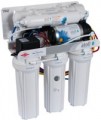Filtration speed
The amount of water that the filter is able to pass through itself per unit of time (of course, effectively purified in the process); usually stated in liters per minute. This parameter is largely related to the type (see above): for example, in jugs, the filtration rate usually does not exceed 0.5 L per minute, while for main devices that supply entire apartments, a throughput of tens or even hundreds of liters is required.
Note that it does not always make sense to pursue a high filtration rate. After all, other things being equal, finer cleaning takes more time; accordingly, the faster the filter works, the higher the chance that the quality of such cleaning will be relatively low. And devices that purify water efficiently and quickly usually have an appropriate price. Therefore, it is worth considering the purpose of the filter and, on the basis of this, determine the balance between the filtration speed and its quality when choosing. It is also worth keeping in mind the conditions of use: for example, if you need to filter low-quality tap water for drinking, it is better to sacrifice speed in favor of efficiency.
Fitting size
The diameter of the pipes to which the filter is designed to be connected; indicated only for models with water connection, see "Connection". In plumbing, pipes of standard diameters are usually used, and inches are used for measurement — for example, 0.75", 1", etc. Most filters are equipped with a set of adapters for different pipe diameters, therefore, most likely there will be no connection problems, even if the initial diameters do not match. Nevertheless, it is best to choose a filter that matches your water supply in terms of fitting size — in this case, the connection is more reliable, and compliance with the claimed characteristics will be complete.
Min. operating pressure
The lowest inlet water pressure at which the filter is able to fully perform its functions. Indicated for models with a connection to the water supply — directly or through a tap (see "Connection").
The design of some filters requires a certain level of inlet pressure for normal operation; if the pressure is insufficient, both throughput and overall filter efficiency suffer, and some functions are not available at all. The latter is especially true for reverse osmosis (see above). Therefore, if the minimum operating pressure is directly indicated in the filter characteristics, you should make sure that your water supply system complies with this parameter before purchasing.
Note that for filters with a booster pump, this column indicates the lowest pressure at which the filter still does not require the use of a pump; see "Pump" for details.
Max. operating pressure
The highest inlet water pressure at which a filter connected to a tap or water supply can operate indefinitely (at least until the resource is exhausted, see above) without breakdowns, failures, etc. In other words, this is the ultimate strength of the filter. Therefore, this parameter has a great importance, and when choosing a filter, you must make sure that it meets the characteristics of the connection point. In this case, it is best to choose a model with a margin: although the device will not break from short-term pressure surges in excess of the working device, but this will create off-design loads and can lead to early failure.
When buying a filter for ordinary domestic use, it can be assumed that the maximum pressure in the water supply, provided for by the housing and communal services standards of most post-Soviet countries, represents 6 atm, but its actual value is usually lower. Therefore, 6 atm filters are quite suitable for the definition of a “model with a margin” for apartments with medium and especially low water pressure.
Replacement cartridges
Models of replaceable cartridges for which the filter is designed. Knowing the names of models, it will be much easier for you to find a replacement for an exhausted cartridge. In addition, the options directly named by the manufacturer are fully compatible with the filter and correspond to official specifications, while there is no such guarantee for "non-native" cartridges.
Several names in this paragraph are usually indicated for filters with multi-stage filtration (see "Stages of purification") — a cartridge for each stage.
Pump
The filter has its own
pump. This feature is found mainly in two types of filters. The first is reverse osmosis systems (see above): the operation of such filtration requires high pressure, but it is not always achieved at the inlet, and a pump, usually electric, is provided to increase the pressure. The second option is tourist filters (see "Type"), where the pump is designed to draw water from natural reservoirs; they have to be pumped manually.

